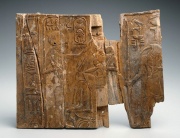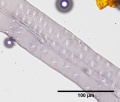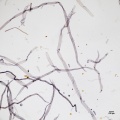Difference between revisions of "Cedar wood"
| Line 7: | Line 7: | ||
[[Alaska cedar]] (Chamaecyparis nootkatensis) | [[Alaska cedar]] (Chamaecyparis nootkatensis) | ||
| − | [[Eastern red cedar]] (Juniperus virginiana) | + | |
| + | [[Eastern red cedar]] (''Juniperus virginiana'') | ||
| + | |||
| + | Honduras cedar (''Cedrala mexicana'') | ||
| + | |||
| + | Incense cedar (''Librocedrus decurrens; Calocedrus decurrens'') | ||
| + | |||
| + | Port Orford cedar (''Chamaecyparis lawsoniana'') | ||
Revision as of 10:56, 25 January 2018
Description
A nonspecific term used for wood from several aromatic evergreen trees. The best known cedar is the Cedar of Lebanon (Cedrus libani) which is native to Asia Minor. Cedars are characterized by having an strong smelling volatile oil whose odor persists after the wood is cut and dried. The wood has a fine grain, is a red and yellow in color and takes a beautiful polish. Cedar is durable and very resistant to insects and rotting. It is used for construction, cabinetry, interior trim, closets, and chest. Cedar shavings were once used as a repellent for (clothes moths) and (carpet beetles), but were not very effective. Other true species of cedar are Atlas cedar (C. atlantica), Cyprus cedar (C. brevifolia), and deodar (C. deodara).
Other CAMEO entries include:
Alaska cedar (Chamaecyparis nootkatensis)
Eastern red cedar (Juniperus virginiana)
Honduras cedar (Cedrala mexicana)
Incense cedar (Librocedrus decurrens; Calocedrus decurrens)
Port Orford cedar (Chamaecyparis lawsoniana)
Synonyms and Related Terms
juniper; cedarwood; cedar chips; cedar shavings; Cedrus libani; cèdre (Fr.); Zedar (Deut.);cedro (It., Port., Esp.)
| Density | 23-35 ppcf |
|---|
Hazards and Safety
Inhalation of dust may cause asthma. Skin contact may cause irritation. Toxic by ingestion.
Other Properties
Paper fiber type: Softwood. Using transmitted light microscopy, fibers appear wide and thin-walled, with small taxodiod ray parenchyma pits. Appearance with Graff "C" stain: varies with pulping and bleaching. Average dimensions of fibers: length 3.5mm; width 30-40μm. Common pulping method: sulfite or kraft.
Additional Images
- 33 Spanish Cedar.jpg
Spanish Cedar (Cedrela odorata)
Sources Checked for Data in Record
- R. J. Gettens, G.L. Stout, Painting Materials, A Short Encyclopaedia, Dover Publications, New York, 1966
- G.S.Brady, Materials Handbook, McGraw-Hill Book Co., New York, 1971 Comment: p. 165
- Hermann Kuhn, Conservation and Restoration of Works of Art and Antiquities, Butterworths, London, 1986
- F. H. Titmuss, Commercial Timbers of the World, The Technical Press Ltd., London, 1965 Comment: 23-33 ppcf
- Michael McCann, Artist Beware, Watson-Guptill Publications, New York City, 1979
- Dictionary of Building Preservation, Ward Bucher, ed., John Wiley & Sons, Inc., New York City, 1996
- Wikipedia, the free encyclopedia, at http://www.wikipedia.com Comment: http://en.wikipedia.org/wiki/Cedrus_libani (Accessed Mar. 20, 2006)
- CRC Handbook of Chemistry and Physics, Robert Weast (ed.), CRC Press, Boca Raton, Florida, v. 61, 1980 Comment: density=30-35 ppcf (0.49-0.57 g/cm3)
- Van Nostrand's Scientific Encyclopedia, Douglas M. Considine (ed.), Van Nostrand Reinhold, New York, 1976
- Random House, Webster's Encyclopedic Unabridged Dictionary of the English Language, Grammercy Book, New York, 1997
- The American Heritage Dictionary or Encarta, via Microsoft Bookshelf 98, Microsoft Corp., 1998




